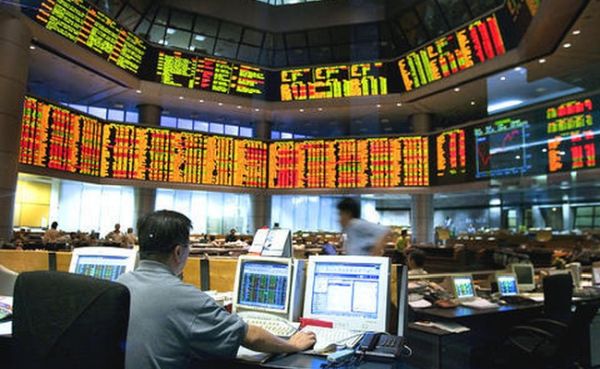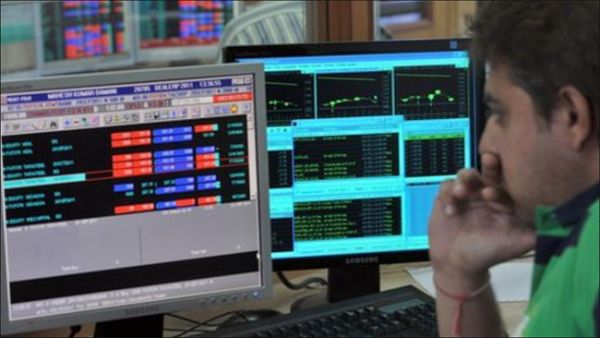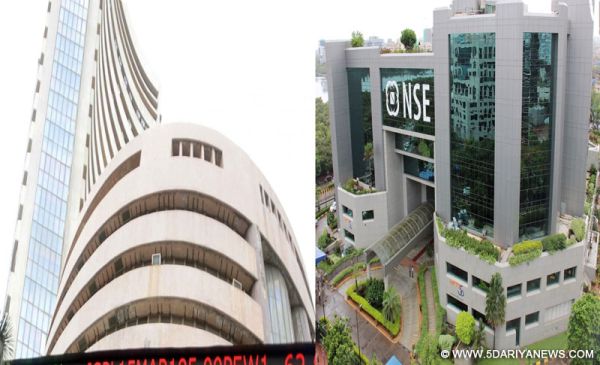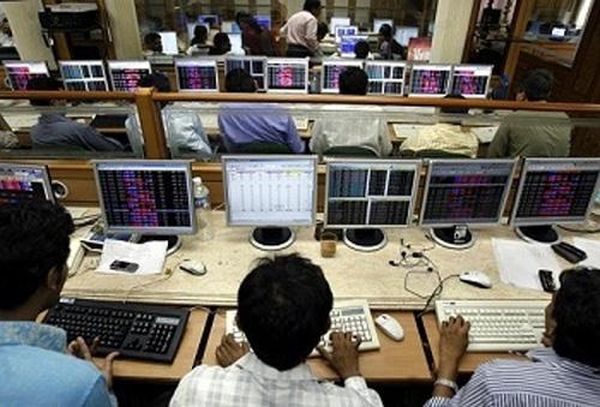
by admin | May 25, 2021 | Economy, Markets, News
 By Porisma P. Gogoi,
By Porisma P. Gogoi,
Mumbai : A global sell-off triggered by trade protectionist measures imposed by major world economies unleashed the bears in the Indian equity markets during the week, pushing the key indices — NSE Nifty50 and BSE Sensex — to their 5-month lows.
Apart from the prospects of escalating trade wars, the risk-taking appetite of investors was marred by rising crude oil prices, the ongoing turmoil in the domestic banking system as well as the uncertainty on the political situation in the country.
On a weekly basis, the barometer 30-scrip Sensitive Index (Sensex) of the BSE shed 579.46 points or 1.75 per cent to close at 32,596.54 points — its lowest closing level since October 23, 2017.
On the National Stock Exchange (NSE), the wider Nifty50 ended below the psychologically important 10,000-mark and closed trade at 9,998.05 points — down 197.1 points or 1.93 per cent from its previous week’s close — its lowest closing level since October 11, 2017.
“Benchmark indices Sensex and Nifty fell 1.75 per cent and 1.93 per cent respectively during the week, posting their longest stretch of weekly losses in 16 months as the domestic market joined a global sell-off triggered by prospects of a trade war,” Arpit Jain, Assistant Vice President at Arihant Capital Markets, told IANS.
According to D.K. Aggarwal, Chairman and Managing Director of SMC Investments and Advisors, the global stock market traded lower after US President Donald Trump announced sweeping tariffs on Chinese goods, a move that has heightened concerns that the global trade war will escalate.
“Back at home, dragged by escalating trade tensions among global economies, the Indian stock market too witnessed selling pressure amid other domestic factors. Since the beginning of the year domestic market witnessed some hiccups on the back of imposition of LTCG (long term capital gains) tax, liquidity issues, rising bond yields and volatile global markets,” Aggarwal told IANS.
“Also, a surge in crude oil prices impacted the market sentiment. The Indian rupee, too, witnessed a volatile move ahead of Fed rate-hike and global trade war concerns,” he added.
On the currency front, the rupee weakened by eight paise to close at 65.01 against the US dollar from its previous week’s close at 64.93.
“Sentiments were affected by rising crude oil prices, bond yields and a troubled domestic banking system. Uncertainty around the political situation in the country added to the woes, and collectively dragged the sentiment across the street,” Gaurav Jain, Director at Hem Securities, told IANS.
Provisional figures from the stock exchanges showed that foreign institutional investors purchased scrips worth Rs 2,524.13 crore and the domestic institutional investors (DIIs) scrips worth Rs 211.91 crore during the week.
Figures from the National Securities Depository (NSDL) revealed that foreign portfolio investors invested in equities worth Rs 2,060.04 crore, or $316.99 million, during March 19-23.
“The market breadth was negative in three out of the five trading sessions of the week. The top sectoral losers were realty, metal, Bank Nifty and pharma indices. There were no gainers,” said Deepak Jasani, Head – Retail Research, HDFC Securities.
The top weekly Sensex gainers were: NTPC (up 2.90 per cent at Rs 170.15); IndusInd Bank (up 1.36 per cent at Rs 1,750.20); Power Grid (up 1.04 per cent at Rs 194.25); Hindustan Unilever (up 0.05 per cent at Rs 1,299.75); and Larsen and Toubro (up 0.01 per cent at Rs 1,267.75).
The losers were: Yes Bank (down 8.37 per cent at Rs 286.70); ICICI Bank (down 7.48 per cent at Rs 275.80); State Bank India (down 7.13 per cent at Rs 234.60); Tata Steel (down 5.65 per cent at Rs 566.60); and Axis Bank (down 4.29 per cent at Rs 501).
(Porisma P. Gogoi can be contacted at porisma.g@ians.in)
—IANS

by admin | May 25, 2021 | Economy, Markets, News
 Mumbai : Key equity indices — NSE Nifty50 and BSE Sensex — receded to their 5-month low levels on Friday as investors got spooked after major world economies imposed new trade protectionist measures.
Mumbai : Key equity indices — NSE Nifty50 and BSE Sensex — receded to their 5-month low levels on Friday as investors got spooked after major world economies imposed new trade protectionist measures.
The global sell-off which impacted the Indian equity market was triggered after the US imposed new levies and tariffs on imports from China which in turn led to retaliatory actions by the Chinese government.
Besides fears over trade wars, a rise in crude oil prices pulled the the Nifty50 of the National Stock Exchange (NSE) below the 10,000-points-level. On a closing basis, the NSE Nifty50 declined by 116.70 points or 1.15 per cent to 9,998.05 points.
The barometer 30-scrip Sensitive Index (Sensex) of the BSE closed at 32,596.54 points — down 409.73 points or 1.24 per cent from the previous session’s close.
During the intra-day trade, the Sensex fell over 500 points to touch a low of 32,483.84 points.
The BSE market breadth was tilted towards the bears with 2,149 declines and 558 advances.
“Markets ended sharply lower on Friday. The weakness came triggered by the latest escalation in trade war between the two large global economies,” Deepak Jasani, Head – Retail Research, HDFC Securities, told IANS.
“The Nifty closed at its lowest level since October 11, 2017, while the Sensex closed at its lowest since October 23, 2017. In its upmove, the Nifty had closed above 10,000 points on July 26, 2017 and now it has closed below that level,” he added.
In terms of the broader markets, the S&P BSE mid cap index dipped by 1.36 per cent and the small cap index by 1.54 per cent.
According to Prateek Jain, Director at Hem Securities: “Global trade war tensions spooked investors today after US President Donald Trump ordered at least $50 billion in tariffs on Chinese imports and China announced plans for reciprocal tariffs on $3 billion of imports from the US.”
“Sentiment remained weak following weak clues from the global market. Overnight, US stocks fell sharply on Thursday, with major indices suffering their worst day in weeks as the threat of a trade war with China sparked a widespread sell-off. The market breadth, indicating the overall health of the market, was quite weak,” said Jain.
On the currency front, the Indian rupee strengthened by 10 paise at 65.01 against the US dollar from its previous close at 65.11.
In terms of investments, provisional data with the exchanges showed that foreign institutional investors purchased scrips worth Rs 1,628.19 crore, while the domestic institutional investors sold stocks worth Rs 935.41 crore.
“Volatility expanded and market is losing its grip due to escalating tensions of trade war and spike in oil prices,” said Vinod Nair, Head of Research at Geojit Financial Services.
“Market corrected 10 per cent from its peak while metal and PSU banks continue to be the laggards. We expect domestic chaos to stabilise as pressure of redemption will be over by the end of FY18 but pre-election volatility may take some time,” Nair added.
Almost all the sub-indices of the BSE ended in the red, barring the IT index (up 23.62 points) and Teck (technology, media and entertainment) index (up 20.61 points).
The S&P BSE banking index plunged by 562.95 points, followed by metal index by 388.51 points, capital goods index by 286.20 points, auto index by 203.77 points and healthcare index by 196.43 points.
Major Sensex gainers on Friday were: Adani Ports, up 0.99 per cent at Rs 361.70; Infosys, up 0.75 per cent at Rs 1167.45; Power Grid, up 0.54 per cent at Rs 194.25; Mahindra and Mahindra, up 0.47 per cent at Rs 733.25; and Coal India, up 0.09 per cent at Rs 269.25.
The Sensex losers were: Yes Bank, down 3.87 per cent at Rs 286.70; Axis Bank, down 3.34 per cent at Rs 501; State Bank of India, down 2.90 per cent at Rs 234.60; ICICI Bank, down 2.73 per cent at Rs 275.80; and Tata Steel, down 2.40 per cent at Rs 566.60.
—IANS

by admin | May 25, 2021 | Economy, Markets, News
 Mumbai : Key Indian equity indices provisionally closed on a lower note on Thursday as negative European markets, along with selling pressure in banking, auto and capital goods stocks, suppressed investors’ sentiments.
Mumbai : Key Indian equity indices provisionally closed on a lower note on Thursday as negative European markets, along with selling pressure in banking, auto and capital goods stocks, suppressed investors’ sentiments.
The key indices had opened on a higher note after the US Federal Reserve raised the benchmark interest rate by 25 basis points, signalling two more rate hikes in 2018.
The wider Nifty50 of the National Stock Exchange (NSE) fell by 40.50 points or 0.40 per cent to provisionally close at 10,114.75 points (at 3.30 p.m.).
The barometer 30-scrip Sensitive Index (Sensex) of the BSE, which opened at 33,206.99 points, closed at 33,006.27 points — down 129.91 points or 0.39 per cent from the previous session’s close.
The Sensex touched a high of 33,281.77 points and a low of 32,963.31 points during the intra-day trade.
The BSE market breadth was bearish with 2,010 declines and 709 advances.
On Wednesday, value buying pushed the key indices higher even as some gains were ceded on caution ahead of the US Federal Reserve’s FOMC (Federal Open Market Committee) meet.
The Sensex closed the day’s trade at 33,136.18 points — up 139.42 points or 0.42 per cent — while the Nifty50 gained 30.90 points, or 0.31 per cent, to close at 10,155.25 points.
—IANS

by admin | May 25, 2021 | Economy, Markets, News
 Mumbai : Key Indian equity indices on Monday hit their lowest levels since December 6, 2017, with the BSE Sensex slipping below the 33,000-mark and the Nifty50 of the National Stock Exchange (NSE) falling below the psychologically important 10,100-level.
Mumbai : Key Indian equity indices on Monday hit their lowest levels since December 6, 2017, with the BSE Sensex slipping below the 33,000-mark and the Nifty50 of the National Stock Exchange (NSE) falling below the psychologically important 10,100-level.
According to market observers, India’s widening current account deficit (CAD), along with weak global cues ahead of the US Federal Reserve meet on March 20-21, dented investors’ risk-taking appetite.
The wider NSE Nifty50 declined by 100.90 points or 0.99 per cent to close on a lower note for the fourth consecutive trade session at 10,094.25 points.
The barometer 30-scrip Sensitive Index (Sensex) of the BSE closed at 32,923.12 points — the fifth straight session of losses — down 252.88 points or 0.76 per cent from its previous close.
The BSE market breadth was bearish with 2,235 declines and 514 advances.
In terms of the broader markets, the S&P BSE mid-cap index declined by 1.58 per cent and the small-cap index by 1.98 per cent.
“Markets ended with heavy losses on Monday. It was the fourth consecutive session of losses for the Nifty. The weakness came on the back of weak global cues ahead of the US Federal Reserve policy decision later in the week,” Deepak Jasani, Head – Retail Research, HDFC Securities.
“Investors were also worried about the sharp widening of current account deficit (CAD) in December quarter. Metals and bank shares came under selling pressure,” he added.
Data released by the Reserve Bank of India (RBI) post market hours on Friday revealed that India’s CAD widened to $13.5 billion during the third quarter of 2017-18 from $7.2 billion in the second quarter and $8 billion in the corresponding period in 2016-17.
On Monday, all the 19 sub-indices of the BSE closed in the red, with the S&P BSE metals index falling by 368.35 points, followed by consumer durables index by 318.81 points, banking index by 301.46 points, oil and gas index by 254.73 points and IT index by 243.58 points.
Vinod Nair, Head of Research, Geojit Financial Services, said: “Market continues to drag under global market volatility ahead of the FOMC (Federal Open Market Committee) meet tomorrow, where consensus hints at a 25 basis points rate hike.
“Bond yield remains at elevated levels and concern on trade tensions is influencing investors to book profit. Back home, rupee weakened due to widening current account deficit and led investors to remain cautious,” Nair added.
On the currency front, the Indian rupee weakened by 23 paise to close at 65.17 against the US dollar from its previous close at 64.94.
In terms of investments, provisional data with the exchanges showed that foreign institutional investors purchased scrips worth Rs 292.23 crore, while domestic institutional investors sold stocks worth Rs 191.52 crore.
Major Sensex gainers on Monday were: NTPC, up 1.03 per cent at Rs 167.05; Maruti Suzuki, up 1 per cent at Rs 8,777.65; Power Grid, up 0.99 per cent at Rs 194.15; Larsen and Toubro, up 0.95 per cent at Rs 1,279.70; and Hindustan Unilever, up 0.80 per cent at Rs 1,309.45.
The Sensex losers were: Tata Steel, down 4.24 per cent at Rs 575.05; Bharti Airtel, down 4.16 per cent at Rs 400.80; Wipro, down 2.60 per cent at Rs 288.05; Yes Bank, down 2.57 per cent at Rs 304.85; and Coal India, down 2.51 per cent at Rs 271.70.
—IANS

by admin | May 25, 2021 | Economy, Markets, News
 By Rohit Vaid,
By Rohit Vaid,
Mumbai : Volatility may persist in the key Indian equity indices, as global cues — prospects of trade wars, rise in US interest rates — and fears of domestic political instability are expected to dent investors’ risk-taking appetite, market observers opined.
“Markets would continue to face headwinds from the evolving political scenario domestically and the prospects of a trade war globally,” Devendra Nevgi, Founder and Principal Partner, Delta Global Partners, told IANS.
“Mixed macros data (points), fiscal year-end issues, higher IPO supply will keep the markets capped and range-bound, with lower bias.”
According to Vinod Nair, Head of Research at Geojit Financial Services: “The long-term outlook for the domestic market continues to be strong. However, rising concerns of global trade headwinds, domestic NPA issues and upcoming state elections will keep the market in tenterhooks.”
“Currently, the market is finding it difficult to stay float at support levels as volatility in global market brought the benchmark indices towards the 200 DMA. US Fed policy meet next week is the key event and the market expects a 0.25 basis points hike.”
Besides US Fed’s meet from March 20-21, investors are expected to keep a close watch on the direction of foreign fund flows and the rupee’s movement against the US dollar.
“Last week, news of the BJP’s defeat in by-polls increased the political risk premium on the rupee. We are in a pre-election year, where every regional electoral event will be seen through the lens of 2019,” Anindya Banerjee, Deputy Vice President for Currency and Interest Rates with Kotak Securities, told IANS.
“Over the next week, the most important economic event remains the US Fed’s decision on monetary policy. We expect a 25 basis points hike and a hawkish tone, which can be positive for the US dollar. As a result, USD-INR may witness a rally towards 65.30 levels on spot. We expect a broad range of 64.80 and 65.30 levels on spot.”
Last week, the rupee strengthened by 24 paise to close at 64.93 against the US dollar from its previous week’s close at 65.17.
On the investment front, provisional figures from the stock exchanges showed that foreign institutional investors (FIIs) purchased scrips worth Rs 6,288.23 crore and the domestic institutional investors (DIIs) worth Rs 202.69 crore during the week.
Figures from the National Securities Depository (NSDL) revealed that foreign portfolio investors (FPIs) invested Rs 6,713.73 crore, or $324.81 million, during March 12-16.
On technical levels, the National Stock Exchange’s (NSE) Nifty50 remains in downtrend.
“Technically, the Nifty remains in downtrend and further downsides are likely early next week once the immediate supports of 10,141 points are broken,” said Deepak Jasani, Head of Retail Research for HDFC Securities.
“Immediate resistance is now at 10,405 points.”
Last week, the key Indian equity indices — the Bombay Stock Exchange (BSE) Sensex and the NSE Nifty50 — receded on the back of political instability, along with the ongoing turmoil in the banking sector and weak global cues.
Consequently, the barometer 30-scrip Sensitive Index (Sensex) slipped by 131.14 points or 0.39 per cent to close at 33,176 points.
Similarly, the wider Nifty50 of the NSE closed the week’s trade at 10,195.15 points — down 31.7 points or 0.31 per cent from its previous week’s close.
(Rohit Vaid can be contacted at rohit.v@ians.in)
—IANS





